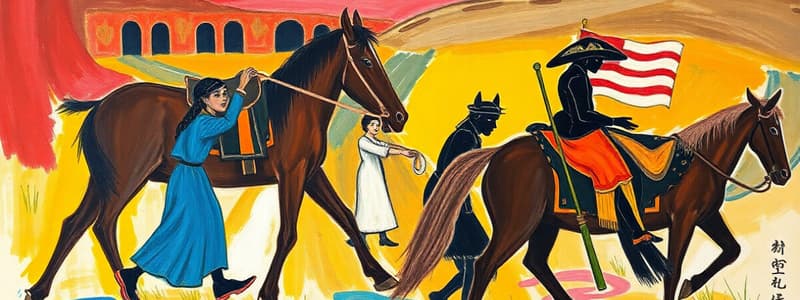Podcast
Questions and Answers
What was a significant social issue during the Jacksonian era from the early 1820s to the early 1840s?
What was a significant social issue during the Jacksonian era from the early 1820s to the early 1840s?
- The rise of women's suffrage
- Debate over slavery in western territories (correct)
- Conflict over Native American land rights
- The introduction of the industrial revolution
How did slavery impact the Deep South during the Jacksonian era?
How did slavery impact the Deep South during the Jacksonian era?
- It grew dramatically (correct)
- It was abolished in certain areas
- It saw a decrease in agricultural production
- It became less important to the economy
What was the response of the national government to the entrenched system of slavery in the Natchez district?
What was the response of the national government to the entrenched system of slavery in the Natchez district?
- They encouraged the migration of freed slaves
- They attempted to abolish it immediately
- They heavily taxed slave ownership
- They worried about alienating local elites (correct)
Which movement began to develop a critique of slavery during this era?
Which movement began to develop a critique of slavery during this era?
What was a commonly held belief about the need for slavery on the southwestern frontier?
What was a commonly held belief about the need for slavery on the southwestern frontier?
Flashcards
Jacksonian Era
Jacksonian Era
Period in US history (early 1820s - early 1840s) when slavery's role in western territories remained largely unchallenged.
Abolitionist Movement
Abolitionist Movement
Movement in northern states that strongly criticized and opposed slavery.
Mexican War
Mexican War
Conflict that marked a significant turning point in the debate about slavery, as it exposed its importance to the southwest.
Southern Slave Auction
Southern Slave Auction
Signup and view all the flashcards
Antebellum America
Antebellum America
Signup and view all the flashcards
Study Notes
Slavery and National Expansion in the United States
- The article examines the interplay of slavery, westward expansion, and national politics in the United States from the Northwest Ordinance to the Civil War.
- Senator Sumner's 1856 speech denounced a bill authorizing the forming of a state government in Kansas, claiming it was a violation and likened it to rape.
- A lithograph from 1856 depicted Liberty, the fair maid of Kansas, as a white woman besieged by "border ruffians" symbolizing Democratic politicians.
- Slavery's expansion into western territories was a contentious issue for 70 years, originating from debates around the Northwest Ordinance and territories acquired from the Louisiana Purchase.
- Three phases of struggle over slavery in the territories are identified; the first from the Northwest Ordinance to the Missouri Compromise, the second encompassing the Jacksonian era (1820s-1840s), and the third beginning with the Mexican War.
- The Northwest Ordinance established the principle of anti-slavery in the Northwest Territory.
- The Missouri Compromise attempted to balance the number of slave and free states.
- The Louisiana Purchase added extensive land; Congress debated whether to allow slavery in these new territories, with proponents arguing that slavery was indispensable for western development.
- The Missouri Compromise (1820) temporarily settled the issue but failed to resolve the fundamental conflict over slavery's expansion.
- The Wilmot Proviso (1846) attempted to restrict slavery’s expansion, failing in the Senate.
- The Compromise of 1850 allowed territories to decide the issue of slavery on their own, leading to unrest.
- The Kansas-Nebraska Act (1854) repealed the Missouri Compromise, opening further territory to the possibility of slavery; this led to significant violence in Kansas.
- The events surrounding the Kansas-Nebraska Act created significant division and foreshadowed the American Civil War by highlighting the deep-seated conflict over slavery.
- The article contends that the expansion of slavery was fueled by multiple interrelated factors. Economically, the booming demand for cotton in both domestic and international markets necessitated an increase in slave labor. Additionally, demographic shifts, such as population growth and migration patterns, played a significant role, while strategic political maneuvering further shaped the debate surrounding slavery's spread.
Studying That Suits You
Use AI to generate personalized quizzes and flashcards to suit your learning preferences.




